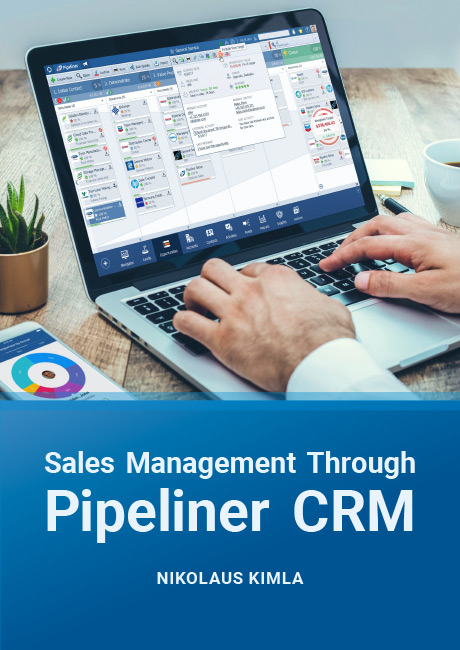What is CRM
- What is CRM?
- Customer Relationship Management Software
- Account Management Software
- Contact Management Software
- Sales Lead Management
- Opportunity Management
- Sales Pipeline Management
- Customer Relationship Mapping
- Sales Enablement Tools
- Sales Management Software
- Sales Process
- Sales Reporting
- Task Management
- Custom Fields
- Team Collaboration
- KPIs for Sales & Leading and Lagging Indicators
- CRM Past Failures?
CRM Past Failures?
CRM has failed in the past. What should it be today?
 Nikolaus Kimla, CEO at Pipelinersales, Inc.
Nikolaus Kimla, CEO at Pipelinersales, Inc.You might find the statement “CRM has failed in the past” to be a bit strong and sweeping. But at the time I brought my company into the CRM space roughly 8 years ago, the predominant phrase heard about the subject from salespeople was this: “CRM sucks!” Additionally, there wasn’t at the time (nor is there still) a clear market leader in the CRM space. The two of these facts put together clearly demonstrates that CRM certainly has not succeeded in the past.
Going back roughly 25 years ago to the original development of CRM and coming forward to fairly recently, it could certainly be said that the first iteration of CRM applications has been a failure. They’ve been costly, incredibly difficult and expensive to implement, and additionally expensive to administrate. These factors comprised the first part of the failure.
The second part of CRM’s failure is that CRM applications, which were developed in a large part to monitor and track sales, were literally forced down users’ (salespeople’s) throats. Nobody bothered to check with salespeople to see what would actually assist them in doing what they were hired to do—make sales. Hence salespeople, when it came to CRM, became little more than glorified dataData Data is a set of quantitative and qualitative facts that can be used as reference or inputs for computations, analyses, descriptions, predictions, reasoning and planning. entry clerks. CRM was so complex and unwieldy that sales reps had to resort to their own devices, such as spreadsheets and copious notes, to actually track and control their own sales.
The other major users of CRM, sales managers, met with equally difficult obstacles. Instead of being able to rely on CRM for the purpose of watching over reps’ progress and the progress of opportunities, they instead had to communicate with salespeople—through emails, in sales meetings and direct contact—to be constantly updated on sales progress.
CRM Past Failures? What Should a CRM Really Be Today?
Despite the explosion of the Internet that brought about a revolution in data, many CRM solutions, including some of the big ones, are still presenting data in spreadsheet-type—albeit glorified spreadsheet-type—formats. These formats do not at all match up with the ways the Internet and new technology have changed how people are thinking and using technology.
Today, too much information bombards a CRM userUser User means a person who uses or consumes a product or a service, usually a digital device or an online service.. For that reason, one function of the new breed of CRMs must be as a guide through all the noise. CRM should provide focus to the user into tasks, activities, and opportunities on which the user should have attention.
For anyone coming newly into the company, CRM should be something that immediately helps the person dive right in and start their job—with no pain. It should be similar to buying a new car; it’s something that is actually a fairly complex operation, but you can just get in and drive.
For any user type within an organizationOrganization Organization is a cohesive group of people working together and formally bound by a shared identity (e.g., one team, company, club, etc.) and a common purpose (e.g., business growth, athletic victory, etc.).—whether it be a salesperson, finance personnel, sales development rep, tech support or any others—the information should be right there, immediately available in real time for one purpose and one purpose only: to help the person make sound management decisions.
Here’s What We’re Doing About It
Interestingly, we brought Pipeliner into the marketplace at a time when the market was actually overrun with CRM applications. But as described earlier there was no clear market leader, and complaints about CRM from salespeople were incredibly abundant.
What was needed from a CRM company was to really figure out what CRM users were actually doing, and how they could best be assisted in getting it done. Or put another way, how we could assist CRM users to work more effectively and efficiently in an ever-changing environment. Such a system needed to be incredibly flexible, and rapidly and easily adaptable.
On top of that, I realized that if we were going to develop a CRM solutionSolution Solution is a combination of ideas, strategies, processes, technologies and services that effectively helps an organization achieve its goals or hurdle its challenges. that users actually used, we would have to, in some way, make it enjoyable and perhaps even fun. Digital gaming had exploded and had become the biggest market on the planet—everyone was into it. For that reason, we made Pipeliner highly visual and even brought “gamification” elements into it.
We brought total visualization into horizontal processes—sales processes—as well into the verticalVertical Vertical refers to a market where a business targets only a small subset of customers such as a specific industry, sector, profession, or niche. For example, manufacturers of jet plane engines cater only to companies that produce or maintain jet planes. processes of each of the sales processSales Process Sales Process is a series of strategic steps or a set of activities aimed at driving sales growth through the alignment of personnel, market insight, methodologies, relevant business units, and technology. stages.
How is CRM Helping Today?
When we set out to develop Pipeliner, we knew that CRM was not assisting salespeople. We decided then to reverse the approach of CRM and make it more of a bottom-up than a top-down model. In other words, we were out to develop an application that would truly empower salespeople, and make it totally worthwhile for them to use CRM.
We knew that if we did so, the quality of the data being input into CRM would be greatly enhanced. That meant that not only sales reps would benefit, but sales management would have a single, central real-time repository for sales data, to which they could look at any time and gain an instant understanding of the current sales scene. Or, as we like to say, instant intelligence, visualized.
Today we have completely brought this vision to reality.
Experience Pipeliner CRM Now
The 6 Deadly Sins of CRM, Causes of Past Failures
We’ve seen where we’ve come from, and where we are now. As we move into the future, I truly believe that any CRM solution, to survive, must avoid these 6 deadly sins:
1. Don’t be a “Big Brother”
George Orwell’s famous novel 1984 gave us the term “Big Brother.” In the story, and it’s use today, the term means having someone constantly watching and monitoring you in order to control you. Nobody likes to live like that—including salespeople or other CRM users.
Pipeliner set out to totally avoid the “Big Brother” syndrome right from the start. Pipeliner’s design is to empower salespeople, not to control them.
2. Don’t make an easy system complex and difficult
A CRM system ⟮such as ours, for example⟯ can be designed to be totally easy to customize and use. But at the same time, when the system is implemented, it can be overloaded with mandatory fields and be made to require twice the data that is really needed.
You should implement a CRM system intelligently. What data is really necessary for users to use it? All customization should be directly target users to help them do their jobs better.
3. “Always access” to CRM
Despite the wide proliferation of Internet access, there are still many places in the world without Internet access. Anyone using CRM, especially salespeople, must have access to the full system with or without Internet access.
Pipeliner has always made this a requirement of its feature set, and always will.
4. Don’t kill your adoption rate before you’ve even started
Steering clear of these CRM deadly sins, especially #1 and #2 above, you will make CRM something users desire to use and will adopt. A complex, control-oriented application that users will find difficult to take to will mean a low adoption rate—and your CRM project has died before it was ever born.
5. Don’t make CRM an island
Although it should certainly be central, a CRM should also not be the only tool that a company or even a sales force depends on. CRM should not be an island—integration is necessary. When you don’t integrate CRM with your other main systems, it becomes a silo—and the age of the silo is long over.
6. Don’t choose a CRM that is slow to set up
Don’t choose a CRM that has a ramp-up time like many of the traditional ones do—3–4 months or longer, and long training periods for users. When a CRM is slow to implement and hard to learn, the motivation for using it starts dipping into minus territory—and you’re back into Sin #4 once again.
If You Don’t Have CRM Today, Success is Unattainable
Today the requirement for processes has become extremely acute—if you don’t have every one of your processes optimized, your business runs less efficiently, which of course can leadLead Lead refers to a prospect or potential customer (who can be an individual or organization) that exhibits interest in your service or product; or any additional information about such entity. to a loss of market share or even failure. Hence the digital revolution is constantly forcing people and companies to think in processes.
Which of course leads us back to CRM. For it is CRM that is expanding to incorporate all of a company’s processes, beginning with its most important activity: sales.
In order for a CRM application to stand up to the demand for processes, and in order for it to integrate and run with them, a CRM:
- the price should be reasonable, so that companies can acquire and implement it with relative ease.
- should be easy and fast to get up and running. Companies can no longer afford administrative runways of months on end, and fortunes spent on administrator training.
- should be intuitive and easy for users to train on. Training times of weeks and months are no longer acceptable—should be hours or, at most, days.
- should empower users, no matter where they exist inside or even outside the company. Users should have their jobs made easier, not more complex.
- should be extremely flexible and customizable, as no 2 companies are alike.
These are the deciding factors of who will win the battle in the CRM industry.
The CRM that meets all these criteria is Pipeliner CRM.



